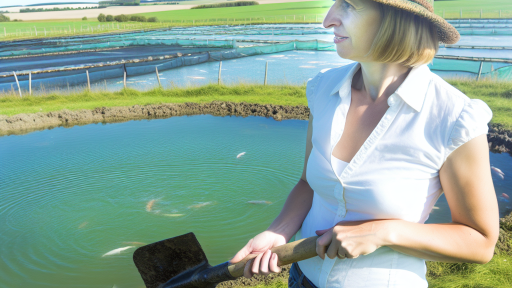Introduction to Breeding Programs
Importance of Breeding Programs
Breeding programs play a crucial role in animal husbandry and agriculture.
They help improve the genetics and productivity of livestock.
Moreover, effective breeding enhances disease resistance in animals.
This leads to improved welfare and overall health of populations.
Benefits of a Successful Breeding Program
A successful breeding program increases the yield of desirable traits.
These traits may include growth rate, milk production, or egg-laying capacity.
Additionally, it contributes to the sustainability of farming practices.
Farmers can reduce their environmental impact through better animal management.
Furthermore, a robust program can lead to economic benefits for producers.
It allows for higher quality products, increasing market competitiveness.
Contribution to Biodiversity
Breeding programs also play a significant role in preserving biodiversity.
They can ensure the survival of endangered species and rare breeds.
Furthermore, they support genetic variation, making populations more resilient.
This resilience is crucial for adapting to changing environmental conditions.
Importance and Benefits
Breeding programs yield multiple advantages across various sectors.
Transform Your Agribusiness
Unlock your farm's potential with expert advice tailored to your needs. Get actionable steps that drive real results.
Get StartedThese programs enhance productivity, sustainability, and biodiversity.
Consequently, they represent a vital aspect of modern agriculture and livestock management.
Defining Objectives
Importance of Clear Goals
Setting clear goals directs the breeding program’s focus.
It helps evaluate the program’s success over time.
Additionally, specific objectives guide decision-making processes.
Identifying Desired Traits
Begin by identifying the traits you wish to enhance.
These might include health, fertility, or growth rates.
Consider traits that align with market demands and consumer preferences.
Developing a Vision Statement
Create a vision statement for the breeding program.
This statement should encapsulate your long-term aspirations.
It serves as a foundational reference for all activities.
Establishing Measurable Goals
Ensure your goals are measurable to track progress effectively.
Specify criteria for success in quantifiable terms.
For example, aim for a 20% increase in fertility rates within three years.
Prioritizing Objectives
Prioritize your objectives based on feasibility and importance.
This helps focus resources where they are most needed.
Evaluate which objectives can yield the greatest impact quickly.
Involving Stakeholders
Engage stakeholders in defining program objectives.
This includes farmers, researchers, and market experts.
Their input can provide valuable insights and enhance commitment.
Reviewing and Adapting Goals
Periodically review your goals to ensure relevance.
Adapt them based on results and changing circumstances.
This flexibility is key to a successful breeding program.
Selecting Genetic Stock
Criteria for Choosing Breeding Animals
Choosing the right breeding animals is crucial for success.
Showcase Your Farming Business
Publish your professional farming services profile on our blog for a one-time fee of $200 and reach a dedicated audience of farmers and agribusiness owners.
Publish Your ProfileBegin by evaluating the health of each potential candidate.
Look for animals with strong, healthy bodies and no genetic disorders.
Next, consider their temperament.
Calm and sociable animals usually produce better offspring.
Additionally, ensure that the animals have good reproductive history.
Examine the fertility rates of both males and females.
It’s also wise to assess their performance in past breeding programs.
Select animals that excelled in their previous roles.
Physical Characteristics
Physical traits play a significant role in breeding programs.
Evaluate size, strength, and overall conformation.
Animals should meet breed standards for optimal results.
Take note of any distinctive markings or features.
These traits can be key selling points for future offspring.
Genetic Diversity Considerations
Maintaining genetic diversity ensures a healthy breeding program.
Inbreeding can lead to health issues and reduced vigor.
Aim for genetic variation to promote resilience in offspring.
Utilize genetic testing to determine lineage accurately.
Collaborate with breeders to access diverse bloodlines.
Behavioral Traits
Behavior also impacts breeding decisions significantly.
Look for animals displaying desirable traits, such as friendliness.
Avoid animals that are overly aggressive or fearful.
Temperament can affect the interaction between animals and handlers.
Positive behavior often results in a smoother breeding process.
Consideration of Environment Adaptability
Adaptability to the environment is an important criteria.
Animals should perform well in various climates and conditions.
Consider the local environment when selecting your stock.
Choose animals known for thriving in similar settings.
This can increase the chances of successful reproduction.
Explore Further: Effective Feed Management Strategies for Aquaculture
Understanding Genetics
Basic Principles of Genetics
Genetics is the study of heredity and variation in organisms.
It explains how traits are passed from parents to offspring.
Understanding genetics helps breeders predict breeding outcomes.
Every characteristic of an organism is influenced by genes.
A gene is a segment of DNA that encodes a specific trait.
Different forms of a gene are called alleles.
Organisms inherit two alleles for each gene, one from each parent.
Genetic Variation
Genetic variation is the diversity in gene frequencies within a population.
This variation is vital for the adaptability and survival of species.
Natural selection acts on this variation, influencing breeding outcomes.
Choosing genetically diverse parents can enhance breeding success.
Showcase Your Farming Business
Publish your professional farming services profile on our blog for a one-time fee of $200 and reach a dedicated audience of farmers and agribusiness owners.
Publish Your ProfileDominant and Recessive Traits
Dominant traits overpower recessive traits during inheritance.
For example, brown eyes may dominate over blue eyes.
Breeders should identify dominant and recessive traits in breeding stock.
This knowledge helps in planning breeding pairings for desired traits.
Understanding Phenotype and Genotype
The phenotype of an organism is its observable characteristics.
The genotype refers to the genetic makeup that produces those traits.
Breeders analyze both phenotype and genotype for informed decisions.
A particular genotype can lead to various phenotypes due to environmental factors.
Inbreeding and Linebreeding
Inbreeding involves breeding closely related individuals.
This practice may increase the likelihood of genetic defects.
Linebreeding is a more controlled form of inbreeding.
It aims to maintain desirable traits while minimizing risks.
Genetic Testing and Tools
Advancements in genetic testing have transformed breeding programs.
Testing can identify carrier statuses for genetic conditions.
Tools like DNA sequencing help breeders make educated choices.
Using genetic tools leads to faster progress in breeding goals.
You Might Also Like: Benefits of Artificial Insemination in Livestock
Formulating a Breeding Plan
Defining Your Goals
Begin by outlining your breeding goals clearly.
Consider what traits you want to enhance in your animals.
Also, think about the market demand for certain characteristics.
This clarity will guide your decisions moving forward.
Researching Breeding Stock
Next, conduct thorough research on available breeding stock.
Evaluate the genetic backgrounds of potential candidates.
Look for individuals that display desired traits significantly.
This step will help you avoid common pitfalls in breeding.
Establishing a Breeding Schedule
Creating a breeding schedule is essential for success.
Determine optimal mating times based on your species’ cycle.
A well-structured timeline enhances reproductive efficiency.
Stay flexible to adapt to any challenges that arise.
Implementing Health Protocols
Health protocols are critical to a successful breeding program.
Ensure all animals undergo regular health screenings.
Implement vaccination and parasite control measures.
Strong health improves fertility and offspring viability.
Data Tracking and Analysis
Regular data tracking is key to evaluating your breeding program.
Document each breeding cycle, gestation, and offspring details.
Analyze this data to identify trends and make informed decisions.
Adjust your strategies based on these insights.
Engaging with the Community
Networking with other breeders can provide valuable insights.
Attend events and join associations related to your species.
Sharing experiences leads to significant learning opportunities.
Showcase Your Farming Business
Publish your professional farming services profile on our blog for a one-time fee of $200 and reach a dedicated audience of farmers and agribusiness owners.
Publish Your ProfileAdditionally, it fosters collaboration for future projects.
You Might Also Like: Sustainable Livestock Farming: Balancing Animal Welfare and Profit

Implementing Health and Management Protocols
Understanding Animal Welfare
Animal welfare is critical in any breeding program.
It involves providing adequate care and humane treatment.
Good welfare practices enhance both quality and productivity.
Farm animals must have access to clean water and nutritious food.
Adequate space and proper housing help reduce stress levels.
Additionally, regular veterinary checks ensure health maintenance.
Developing Health Protocols
Establishing clear health protocols is essential for success.
Begin by conducting thorough health assessments of all animals.
Ensure vaccination schedules are in place and strictly followed.
Regular deworming is crucial to prevent internal parasites.
Monitor animal health indicators to identify any issues early.
Record keeping aids in tracking health trends over time.
Implementing Management Strategies
Management strategies directly affect the success of breeding efforts.
Establish a nutrition plan tailored to your breeding objectives.
Proper nutrition fosters growth and reproductive success.
Implement a breeding schedule that maximizes productivity.
Track the performance of each breeding pair for improvements.
Utilize training for staff to ensure they understand best practices.
Ensuring Environmental Standards
The environment plays a vital role in animal health and productivity.
Maintain cleanliness in housing to reduce disease risks.
Implement biosecurity measures to protect against infections.
Proper waste management systems reduce environmental impact.
Evaluate the need for shelter that offers protection from harsh conditions.
Search for ways to improve air quality in animal enclosures.
Building a Support System
Collaboration with professionals enhances management capabilities.
Engage veterinarians for regular health assessments and advice.
Consult animal nutritionists to optimize dietary plans.
Connect with fellow breeders to share knowledge and resources.
Consider joining breeding associations for up-to-date insights.
Network with researchers for access to innovative practices.
Discover More: Advanced Breeding Technologies for Modern Farmers
Data Collection and Record Keeping
Importance of Data Collection
Data collection is vital for a successful breeding program.
It allows you to track genetic progress over generations.
Additionally, it enables informed decision-making regarding breeding pairs.
Types of Data to Collect
Collect various types of data to ensure comprehensive insights.
- Phenotypic data on physical traits.
- Genotypic information to assess genetic diversity.
- Health records to monitor diseases and conditions.
- Performance records to gauge production capabilities.
Methods of Data Collection
Implement systematic methods to collect data accurately.
Use software applications designed for breeding programs.
Additionally, consider manual record-keeping for detailed observations.
Showcase Your Farming Business
Publish your professional farming services profile on our blog for a one-time fee of $200 and reach a dedicated audience of farmers and agribusiness owners.
Publish Your ProfilePhotographic evidence can also enhance records.
Record Keeping Systems
Establish a robust record-keeping system for all collected data.
Electronic databases offer efficiency and ease of access.
Alternatively, use spreadsheets for flexibility and customization.
Ensure regular backups to prevent data loss.
Tracking Progress and Outcomes
Tracking progress is crucial to evaluate breeding effectiveness.
Regular analysis of the data enables adjustment of strategies.
- Monitor traits for growth and improvement.
- Assess the health and vitality of offspring.
- Evaluate overall success based on breeding goals.
This approach enhances the overall success of your breeding program.
Evaluating and Adjusting the Program
Importance of Evaluation
Regular evaluation of the breeding program enhances its effectiveness.
This process helps identify strengths and weaknesses.
Additionally, evaluation allows for informed decision-making.
Without evaluation, improving the program becomes challenging.
Gathering Data
Data collection is essential for effective evaluation.
Utilize tools like performance metrics and genetic reports.
Engage with breeders to gather first-hand observations.
Surveys can provide valuable insights from stakeholders.
Moreover, genetic diversity assessments offer crucial information.
Analyzing Results
Analyzing results facilitates understanding program performance.
Utilize statistical methods to interpret collected data.
Compare results against established benchmarks for context.
Look for trends that indicate areas for improvement.
Share findings with team members to foster collaboration.
Implementing Changes
Implementing changes is a vital step in program improvement.
Based on analysis, prioritize adjustments that yield the most benefits.
Communicate changes clearly to all team members.
Establish timelines for implementing adjustments.
Monitor the impact of changes on program outcomes closely.
Continuous Improvement Strategies
Continuous improvement should be a key focus for your program.
Regularly revisit and update evaluation processes.
Encourage feedback from all participants to foster insight.
Stay informed about new research and techniques in breeding.
Invest in training and development for team members.
Celebrating Successes
Recognizing achievements boosts morale and motivation.
Celebrate milestones to reinforce positive behaviors.
Share success stories to inspire the team and stakeholders.
Establish awards or recognitions for exemplary performance.
Maintain a culture of gratitude and appreciation within the team.
Additional Resources
Principles for successful livestock grazing management on western …




